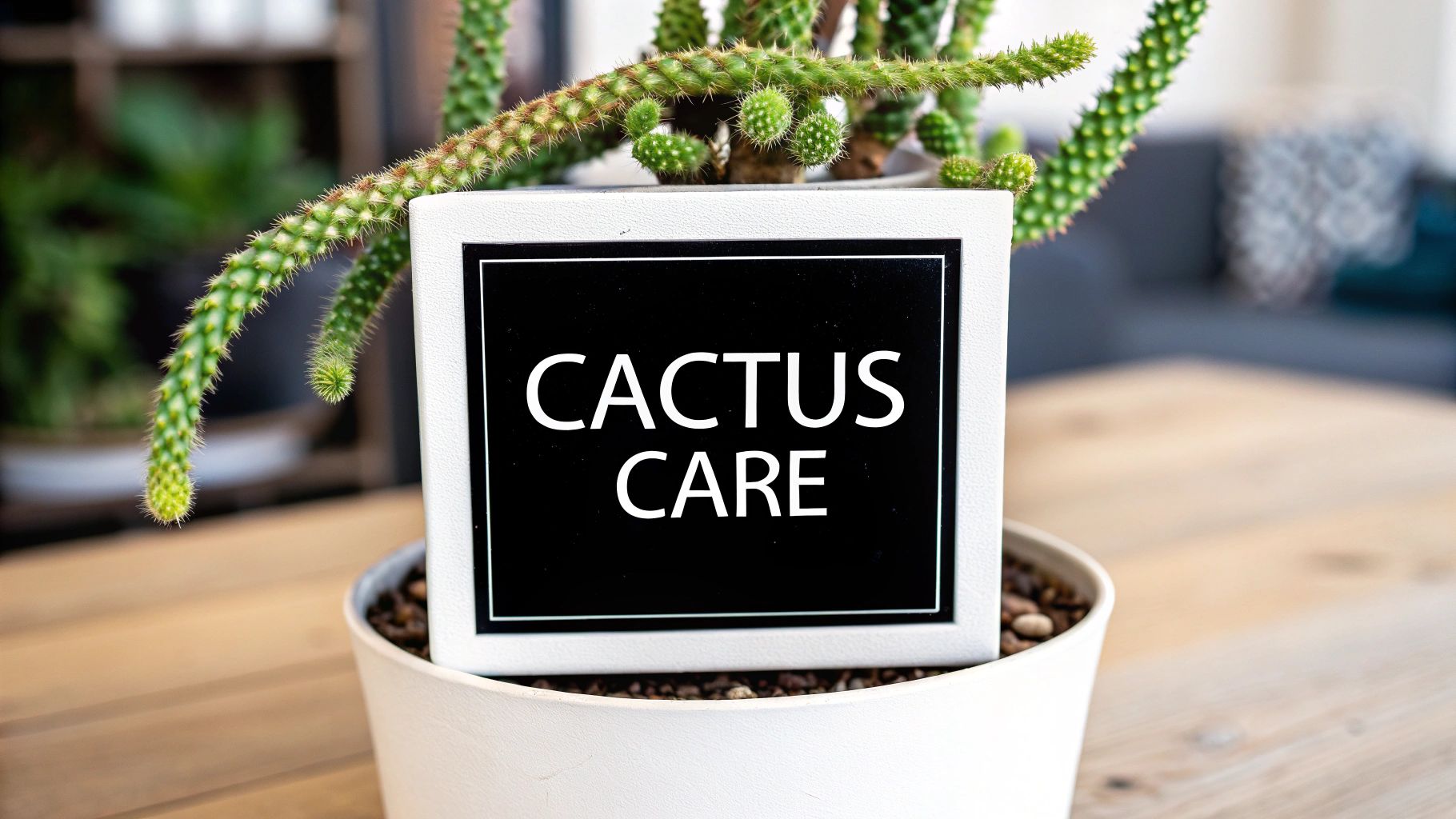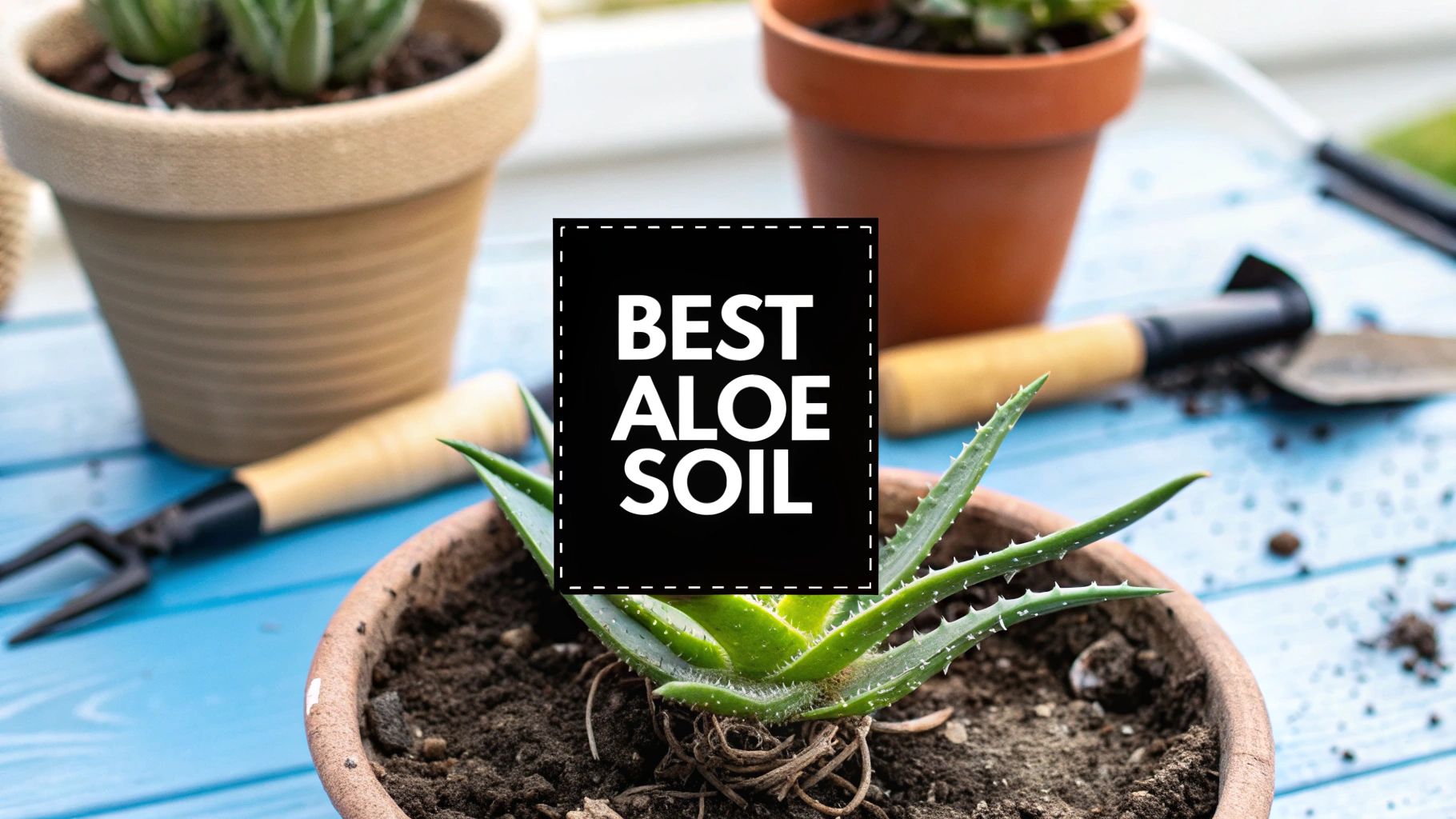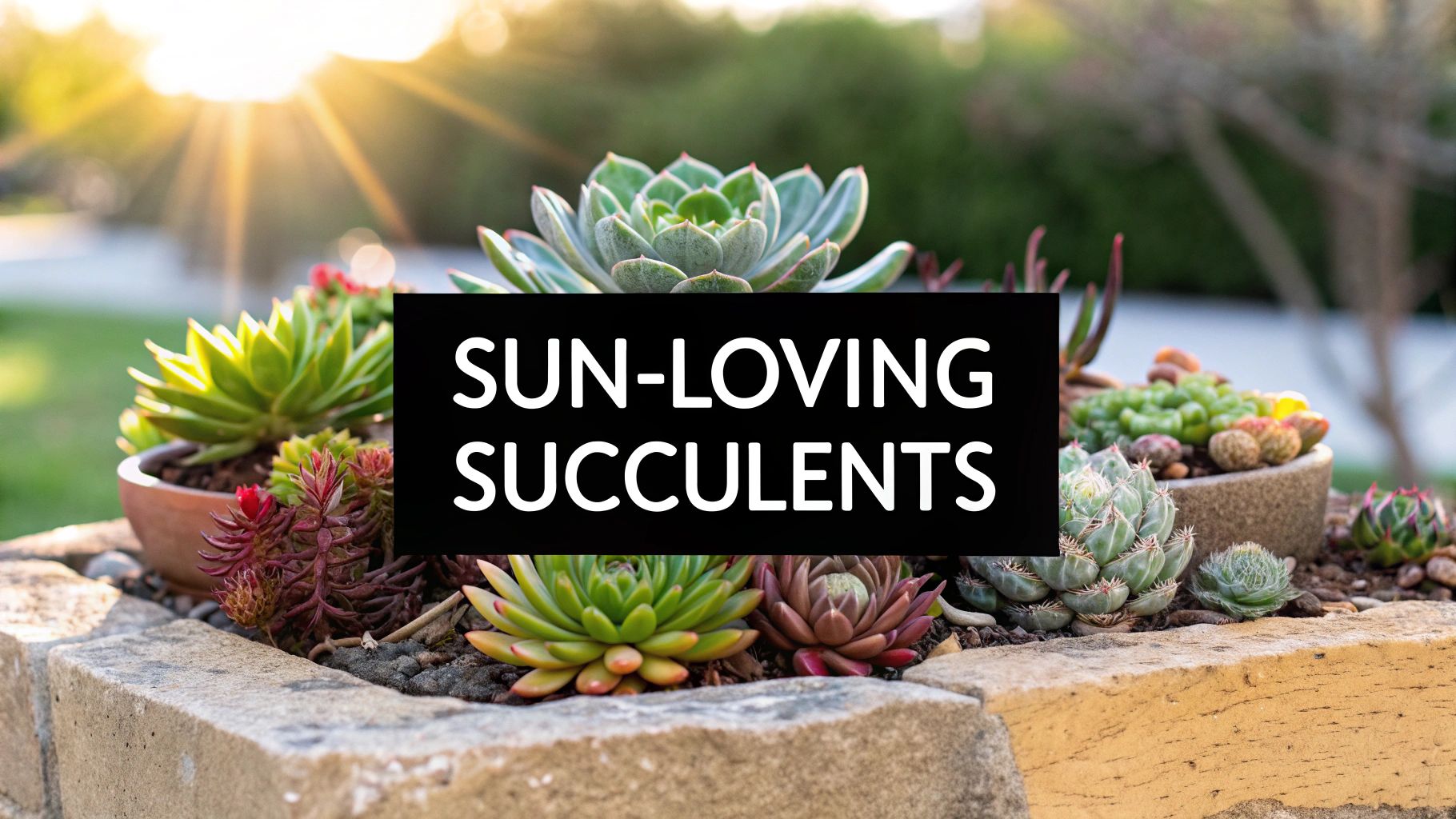The secret to keeping a Monkey Tail Cactus happy is to think about where it comes from. This isn’t your average cactus. It thrives with plenty of bright, indirect sunlight, a good drenching only when it's bone dry, and a super gritty soil mix that lets water rush right through. If you can mimic its natural home, you’re already on the path to success.
Your Guide to the Monkey Tail Cactus
The Monkey Tail Cactus, or Cleistocactus colademononis if you want to get technical, is one of those plants that just stops you in your tracks. But to really grow it well, you have to understand its wild roots.
This cactus is a bit of an oddball. It doesn't grow in a sandy desert but on the rocky cliffsides of Bolivia. It's an epilithic plant, which is a fancy way of saying it hangs onto rocks for dear life. Thinking about that high-altitude, rugged environment is the key to unlocking its care needs. This isn't a plant that likes sitting in deep, rich garden soil; it's used to anchoring shallow roots into tiny crevices, grabbing moisture when it can.
What Makes This Cactus So Special
Once you picture it clinging to a cliff, its care just clicks into place. Of course it hates being overwatered and needs soil that drains in a flash—it’s not built to have its roots sit in soggy soil. In its natural home, those long, trailing stems are designed to store water, and the signature soft, hair-like spines do more than just look cool. They act as a natural sunscreen and help pull moisture from the air.
While a Monkey Tail can grow up to an incredible 8.2 feet in the wild, you can expect yours to reach a more manageable 35 inches indoors. It's the perfect statement plant for a hanging basket. You can learn more by reading about its unique growth habits.
Here are a few of my favorite things about this plant:
- Cascading Stems: The long, flexible stems covered in soft, white "fur" look incredible tumbling out of a hanging planter.
- Harmless Spines: Unlike most of its prickly cousins, its spines are soft and fuzzy. You can actually handle this cactus without fear.
- Vibrant Flowers: Once it matures, you'll be rewarded with stunning, tubular red or pink flowers in spring and summer that are truly a sight to behold.
Monkey Tail Cactus Care At a Glance
To get started on the right foot, it helps to have a quick reference guide. Think of this table as your cheat sheet for providing the best possible environment for your plant.
Expert Tip: The biggest mistake I see people make is treating the Monkey Tail like a typical houseplant. Always think "rocky cliffside," not "lush rainforest," when deciding on water, soil, and light. This mental shift is everything.
It summarizes the core needs we'll explore in greater detail throughout this guide, making it easy to see what your cactus needs at a glance.
| Care Aspect | Ideal Conditions |
|---|---|
| Light | Bright, indirect sunlight; a few hours of gentle morning sun is ideal. |
| Water | Water thoroughly only when soil is completely dry. Reduce in winter. |
| Soil | Fast-draining cactus/succulent mix with added perlite or pumice. |
| Temperature | 60-80°F (15-27°C) during the growing season. |
| Pot Type | Hanging basket or pot with excellent drainage holes. |
With these basics in mind, you'll be well-equipped to give your Monkey Tail Cactus the care it needs to flourish.
Finding the Perfect Light and Temperature
Getting the light and temperature right is probably the single most important thing you can do for your Monkey's Tail Cactus. To really nail it, you have to think like the plant. Picture its native home on the high-altitude cliffs of Bolivia—it gets blasted with intense sun, but it's also often tucked away in crevices, getting some relief from rocky ledges. Your job is to mimic that balance.

This cactus absolutely loves bright, indirect light. A little direct morning sun is perfectly fine and often appreciated, but the harsh afternoon sun is a definite no-go. An east-facing window is pretty much the gold standard, giving it that perfect dose of gentle morning light without any risk of scorching.
What if all you have is a south or west-facing window? No problem. Just hang a sheer curtain to filter that intense light. This simple step creates a dappled effect, much like the natural shade it would find in the wild, and keeps its beautiful, fuzzy stems from getting sunburned.
Reading Your Plant’s Light Signals
One of the best things about the Monkey's Tail is that it's not shy about telling you what it needs. You just have to learn how to read the signs.
Pay close attention to these clues:
- Pale, stretched-out stems: If your cactus starts looking long, thin, and a bit faded, it's a classic case of etiolation. This is your plant literally stretching itself out, desperately searching for more light.
- Yellow or brown patches: See crispy, discolored spots on the stems? That's a sunburn. It's a clear signal that the direct sun is too intense, and you need to move it right away.
- Lush, dense growth: When you've found the sweet spot, you'll know it. The stems will be a rich, vibrant green, covered in those signature thick, soft spines. This is what success looks like.
If your home is naturally on the darker side, don't give up. A good full-spectrum LED grow light can be a total lifesaver, especially during the gloomy winter months. Just make sure to position it correctly so it provides consistent, bright light without being so close that it burns the plant.
The Ideal Temperature Range
This cactus is pretty easygoing when it comes to temperature, which is great news for us. It’s happiest in the same conditions we are, thriving in a range between 60-80°F (15-27°C). This makes it an ideal houseplant.
What it doesn't like are sudden drafts or extreme temperature shifts. Keep it away from open windows in the winter, A/C vents, or radiators. Those quick changes can really stress the plant out, leaving it open to pests and other issues.
A Pro Tip: To encourage a spectacular bloom in the spring, you can give your cactus a winter rest. Lowering the temperature to a cooler 50-60°F (10-15°C) and cutting back on water tells the plant it's time to go dormant. This little chill period is often the trigger for flowering.
And a final word of warning: while it's a tough plant, it has zero tolerance for frost. If you enjoy putting your cactus outside for the summer, make sure you bring it back in long before the first frost is expected. A freeze will kill its water-filled stems almost instantly.
Nailing the Watering and Soil Mix
Getting the watering and soil just right is the absolute foundation for a happy Monkey's Tail Cactus. If there's one thing I've learned, it's that you have to toss out any idea of a rigid watering schedule. These plants work on their own time, and the biggest mistake you can make is overwatering. It's the number one killer, leading to root rot, but it’s also completely avoidable.

The trick is to master the "soak and dry" method. Think about where these cacti come from—the rocky cliffs of Bolivia. They're used to long dry spells followed by a sudden downpour. So, when you water, give the pot a complete drenching until water pours out of the drainage holes. Then, and this is the most important part, let that soil become bone dry before you even consider watering again.
The Perfect Soil Recipe
Your average, off-the-shelf potting soil is a no-go for a Monkey Tail. It's designed to retain moisture, which is precisely what will suffocate and rot the roots of this plant. You need a mix that drains incredibly fast.
While you can grab a pre-made cactus and succulent mix, I find that making my own gives me better results. It's easy, and you know exactly what’s in it. Here’s a simple, effective recipe I swear by:
- One part potting mix: Just a little bit for nutrients and to give the roots something to hold onto.
- One part perlite or pumice: These create essential air pockets in the soil, preventing it from getting compacted and waterlogged.
- One part coarse sand or fine gravel: This is what gives you that sharp, rapid drainage you're looking for.
This blend creates a gritty, airy home for your cactus roots. It lets water flush through quickly, preventing the dreaded "wet feet" that lead to rot, while still giving the plant a stable base to grow from.
How to Know When It's Time to Water
So, how do you really know when the soil is "completely dry"? Don't just poke the top inch; it can be dry on the surface but still damp down where the roots are. You need to play detective.
Here are a few tried-and-true methods:
- The Finger Test: This is the classic for a reason. Stick your finger about two inches down into the soil. If you feel even a hint of coolness or moisture, it's not time yet.
- The Lift Test: Get to know the weight of your pot right after you've given it a good watering. Pick it up every few days. You'll be surprised at how much lighter it feels when the soil has dried out.
- Check the Cactus: A thirsty Monkey Tail might start to look a little less plump or even slightly shriveled. This is your sign that it’s dipping into its water reserves and is ready for a drink.
In the spring and summer, when the plant is actively growing, this could mean watering every couple of weeks. But that’s just a rough estimate—your home's temperature and humidity play a huge role. Always trust the soil, not the calendar. The general principles here are similar to those for many succulents, and you can learn more by reading up on how to water succulent plants.
A Pro Tip: The key to a thriving Monkey's Tail is adapting to the seasons. Its needs shift dramatically from summer to winter, and getting this right is what separates a surviving plant from a truly flourishing one.
Once fall and winter arrive, the plant enters a dormant period. Growth slows to a crawl, and its water needs plummet. You'll want to cut back on watering drastically—maybe once a month, or even less frequently. This winter rest isn't just about survival; it's what triggers the cactus to produce those stunning red flowers in the spring. If you start watering normally too soon, you might miss out on the bloom show entirely.
How to Propagate and Repot Your Cactus
One of the best parts of growing a Monkey’s Tail is watching your collection expand. Whether you’re making new plants to share with friends or just giving your main cactus a bigger home, propagation and repotting are pretty straightforward once you get the hang of it.
The go-to method for making more Monkey's Tail cacti is by taking stem cuttings. It’s essentially cloning, so you know the new plant will have the same fantastic, hairy look as its parent. The whole process really just boils down to making a clean cut and having a bit of patience.
Propagating Your Monkey Tail Cactus
First, find a healthy, good-looking stem on your plant that’s at least four to six inches long. You’ll want to use a sharp, sterile knife or shears for this part. A clean cut is crucial because it prevents crushing the stem and keeps bacteria out, giving your new cutting the best shot at life.
After you’ve made the cut, the most important step is next: letting it callus over. Don't skip this! Just place the cutting in a dry spot with good air circulation, away from direct sun, for a few days up to a week. You’ll know it’s ready when the cut end is dry to the touch and has formed a tough little seal. This callus is what stops the cutting from sucking up too much water and rotting before it can even grow roots.
This graphic really simplifies the whole process.

As you can see, it's a simple flow: cut, callus, and then plant. Nailing these three stages is the foundation for success.
Once the end is properly callused, it's planting time.
- Grab a small pot and fill it with a quality, fast-draining cactus mix.
- Gently push the callused end about an inch or two into the soil.
- Here’s the hard part: don’t water it yet! I know it’s tempting, but wait at least a week. This gives the new roots a chance to start forming without being drowned.
If you want to give your cutting a little boost, dipping the callused end in rooting hormone powder right before planting can really speed up root growth. For a deeper dive, this guide on propagating succulents from cuttings has a ton of great visuals and extra tips.
When and How to Repot Your Cactus
Repotting is an important part of long-term care, but the good news is you won't be doing it all the time. These cacti actually like being a little root-bound, so they typically only need a new pot every 2-3 years. The ideal time to do this is in the spring, right as the plant is kicking into its active growth phase.
So, how do you know it's time? Look for these tell-tale signs:
- You see roots poking out of the drainage holes.
- The plant looks wobbly or too big for its pot.
- Water rushes right through the soil when you water it. This usually means the pot is more roots than soil.
When you're ready to repot, the process is simple, but you'll want to be gentle. Even though the spines are soft, a pair of gloves can make handling the long, trailing stems a lot easier. Slide the cactus out of its current pot and take a look at the roots. If you see any black, mushy spots (a sign of rot), trim them off with clean shears.
A good rule of thumb is to only go up one pot size—about one to two inches wider in diameter. A pot that’s too big will hold onto excess moisture, which is the fastest way to cause root rot.
Settle the plant into its new pot with fresh cactus soil, filling in around the root ball. And just like with propagation, hold off on watering for about a week. This little waiting period lets any damaged roots heal up and helps prevent transplant shock, setting your Monkey's Tail up for a few more years of happy, cascading growth.
Solving Common Problems And Pest Issues
Even the most attentive gardener hits a bump when caring for a Monkey’s Tail Cactus. It might droop, discolor, or show strange spots—but don’t panic. This cactus is tough, and it practically shouts its needs if you learn to read the signals.

Most hiccups fall into three buckets: water, light, and the occasional unwelcome critter. Spot problems early and you’ll nip them in the bud—keeping your cactus looking full, lush, and cascading just as it should.
Decoding Common Symptoms
When your cactus isn’t at its best, its stems speak volumes. Here’s what to watch for:
-
Yellowing Stems
Roots drowning in moisture lose their job: feeding the plant. Overwatering is almost always the culprit. Pause all watering, let the soil dry out, and inspect moisture levels several inches down. For an in-depth look at yellowing issues, see why your cactus is turning yellow. -
Shriveled Stems
Wrinkled skin means your cactus is dipping into its internal water bank. Confirm the soil is bone dry before you water. A thorough soak will plump those stems back up within a day or two. -
Mushy Base
Soft, squishy tissue at the bottom is a red flag for root rot. Act fast: gently unpot the plant, snip off blackened or soft roots, and repot in fresh, fast-draining cactus mix.
Dealing With Unwanted Pests
No plant is completely immune. Monkey’s Tail Cactus can attract mealybugs or spider mites—tiny invaders that feed on sap. Catching them early makes removal straightforward.
- Mealybugs: Tiny, white fluff clusters in stem junctions. They move slowly but multiply quickly.
- Spider Mites: Look for fine webbing between stems. These pests are nearly invisible until the webbing appears.
For light infestations, dip a cotton swab in 70% isopropyl alcohol and dab each pest. The alcohol breaks down their protective coating on contact.
If you spot more than a few bugs, reach for insecticidal soap or a neem oil spray. Cover every inch of the plant—including undersides—and repeat every 5–7 days until the pests vanish.
Here’s a handy diagnostic table to keep by your potting bench:
Common Monkey Tail Cactus Issues And Solutions
Before you grab your tools, scan this quick guide to match symptoms with fixes.
| Symptom | Potential Cause | Solution |
|---|---|---|
| Yellowing Stems | Overwatering | Let soil dry out fully; reduce watering frequency. |
| Shriveled Stems | Underwatering | Confirm soil is completely dry, then water deeply. |
| Mushy Base | Severe Root Rot | Remove plant, trim rotten roots, repot in fresh, dry cactus mix. |
| White Fluffy Spots | Mealybugs | Spot-treat with rubbing alcohol or apply insecticidal soap. |
| Fine Webbing | Spider Mites | Spray with neem oil or insecticidal soap, ensuring thorough coverage. |
Catching issues in the early stages saves your cactus—and your peace of mind.
Stay observant, respond promptly, and your Monkey’s Tail Cactus will reward you with healthy, flowing stems year after year.
Answering Your Top Monkey's Tail Questions
Even the most seasoned plant owners run into questions. This is where we tackle the common "what ifs" and "why is this happening" moments that come with growing a Monkey's Tail. Think of it as a quick chat with an expert, designed to solve those little mysteries that pop up.
We've gathered the most frequent questions from fellow growers to help you fine-tune your care routine. From coaxing out those incredible flowers to keeping your furry friends safe, let's get you some clear answers for real-world situations.
Why Are the Tips of My Monkey Tail Cactus Turning Brown?
It's a common sight and definitely a little scary—the tips of those beautiful, furry stems turning brown and crispy. Don't panic. Nine times out of ten, this points directly to a watering or light issue.
Most often, you're looking at a classic case of underwatering. The cactus is smart; it sends water to its base and core first. If there isn't enough moisture to make it all the way down those long, cascading stems, the tips are the first to dry out.
But sometimes the sun is the culprit. If your plant is getting scorched by intense, direct afternoon sun, those delicate tips can literally get a sunburn.
Here’s how to play detective:
- Feel the Soil: Stick your finger a few inches into the pot. Is it completely parched? You've found your answer. Your plant is thirsty. It’s time to give it a more thorough soak during your next watering session.
- Watch the Light: Pay attention to the sun's path throughout the day. If your cactus is getting blasted for hours, it's time for a new home. Move it somewhere with bright, indirect light.
- Check Your Water Source: This is less common, but a buildup of minerals from hard tap water can sometimes cause browning tips. If you've ruled out water and light, try switching to filtered or distilled water for a while and see if that helps.
How Can I Encourage My Monkey Tail Cactus to Bloom?
Getting a Monkey's Tail to flower is the ultimate reward, but it won’t happen on its own. The secret isn't some magic fertilizer; it's about tricking the plant into thinking it has survived a winter.
To get those incredible red flowers, you have to give your cactus a cool, dry rest period. If you keep it in a warm, cozy spot with regular water all year, it will be perfectly happy to just keep growing stems, but it will never feel the trigger to bloom.
To trigger flowering, you must give it a winter. As the days get shorter in the fall, cut way back on watering—maybe just a tiny bit once a month. Then, move it to a cooler spot in your home, somewhere that stays around 50–60°F (10–15°C). This tells the plant it's time to rest and store up energy.
Once spring rolls around, you can wake it up. Gradually move it back to its sunny spot and start watering it normally again. To give it an extra boost for flowering, a monthly feeding with a high-potassium fertilizer during the spring and summer will provide the fuel it needs to produce that stunning floral show.
Is the Monkey Tail Cactus Safe for Pets?
This is a big one for any of us with four-legged family members, and luckily, the news is good. Yes, the Monkey's Tail Cactus is considered non-toxic to cats and dogs. If your cat bats at it or your dog takes a curious nibble, it's highly unlikely to cause any serious harm or poisoning.
However, "non-toxic" doesn't mean it's a chew toy. While the spines are famously soft and more like hair than needles, they can still be irritating. A mouthful of fuzz can cause some minor discomfort to a pet's gums or paws.
The best strategy is to simply keep it out of reach. A hanging basket is a perfect solution—it not only keeps your pets from getting too curious, but it's also the best way to show off those incredible, trailing stems.
At The Cactus Outlet, we provide a wide selection of healthy, high-quality cacti to help you build the collection of your dreams. Explore our stunning varieties and find your next statement plant at https://www.cactusoutlet.com.




